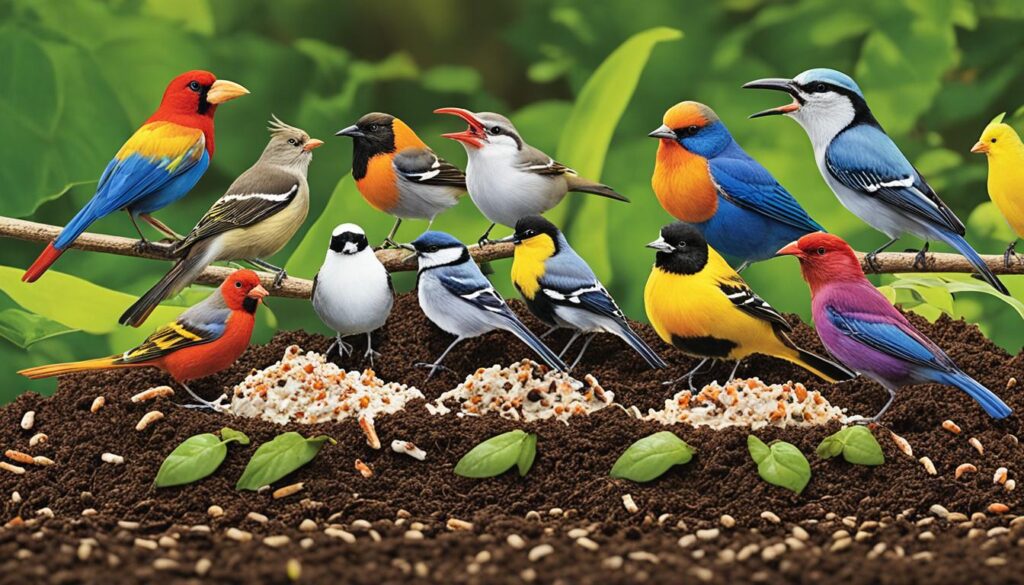Some bird species can eat up to 30,000 prey items in a year. This includes worms, insects, and other invertebrates. These birds are very active. Worms are a big part of many backyard and garden birds’ diets. They are a key source of protein.
American Robins and European Starlings are just a few of these worm-eating birds. They help control insect numbers. This is good for the health of their environment. We will look at the birds that love worms. We will see how they eat and the good stuff worms give them.
Key Takeaways:
- Many common backyard and garden birds eat lots of worms.
- Worms are full of protein and easy for birds to find and eat.
- Birds have special ways to look for and get worms, like sharp eyes and beaks.
- Eating worms helps birds keep down insect numbers and keep nature healthy.
- Knowing what worm-eating birds eat is important for people who watch birds, garden, and protect nature.
Introduction to Birds that Eat Worms
Many bird species love to eat worms. For birds like the American Robin and the European Starling, worms are a tasty snack full of nutrients. They are known as worm-eaters or vermivores.
Why Birds Love Worms
Worms offer a lot to birds. Their high protein content is great for energy. They are easy to find for ground-dwelling birds, like the American Robin.
These birds can get worms from the soil easily. This means they get a lot of benefits from a wormy diet. Worms help these birds grow and stay active.
Vermivore: The Scientific Term for Worm-Eating Birds
The official name for worm-eating birds is vermivore. This includes birds like the American Robin and the Eurasian Blackbird. They are specially built to eat worms.
Understanding these birds’ eating habits is key. It helps us see how important they are in nature. Worm-eating birds play a big role in the ecosystem.
Recent studies show bird diets often include earthworms. In North America, around two-thirds of the earthworm species are from here. But, 33% of the types found there are not native.
These numbers show that worms are crucial in birds’ food chains.
“Earthworms typically make up about three-quarters of a woodcock’s diet.”
Worms are vital for many bird species. They offer great nutritional value. As we learn more about what these worm-eating birds eat, we understand their role better.
American Robin: The Quintessential Worm-Eater
The American Robin is a well-known bird across North America. It’s recognized by its bright reddish-orange chest. These birds are not just pretty; they’re also famous for eating earthworms. This makes them the top worm-eaters in the bird world.
In spring and summer, when the ground is soft and worms are easy to find, robins eat a lot of them. For some robins, worms can be half of what they eat each day. They’re really good at pulling worms from the ground.
Robins use their sharp eyes to see signs of worms on the surface. They listen for worms moving underground, too. When they find a worm, their beaks help them eat it right away.
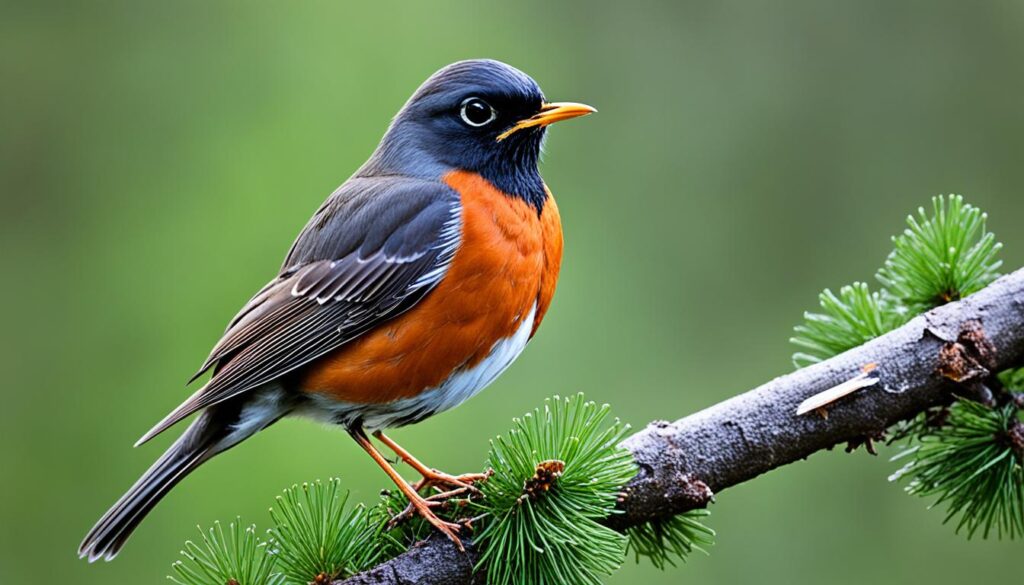
It’s more than just a favorite snack for robins. Worms are packed with protein, great for building bird babies and keeping adults healthy. This is especially important when robins are raising their families.
But robins also eat other things, especially in the fall and winter. They enjoy berries from different trees. This varied diet helps them live in all kinds of places, from cities to meadows.
American Robins are clever and adaptable. They do more than just eat worms. They help keep nature in balance by using worms as a key food source.
European Starling: An Invasive Worm-Feasting Species
The European Starling is known across North America. It’s a bird with black feathers and a shiny look. It loves to eat earthworms and other small animals. This bird has come from Europe and now competes with local birds for food.
Starlings’ Specialized Worm-Hunting Techniques
European Starlings have strong, thin beaks for pulling earthworms from the ground. They look for worms in open spaces using their good eyesight and hearing. They’re experts at finding and eating earthworms.
They also eat fruits, grains, and seeds. But, earthworms are their favorite meal. Their wide food choices help them live in many places, making them successful invaders.
| Characteristic | Measurement |
|---|---|
| Weight | 2.1-3.4 ounces |
| Length | 7.9-9.1 inches |
| Wingspan | 12.2-15.8 inches |
In the late 19th century, the European Starling was brought to the USA. Now, it’s found everywhere, from cities to the countryside. These birds can live in many different places.
However, they can also cause problems. Their big groups eat a lot of crops, which can hurt farmers. But, they also help by eating harmful bugs.
The European Starling shows how clever it is by finding food in new places. It’s now a common bird in North America, known for its great and sometimes not so great impacts.
Common Blackbirds: Thrushes that Thrive on Worms
The common blackbird belongs to the thrush family and is seen a lot in Europe, Asia, and North Africa. They love to eat earthworms, a rich source of protein. This is very important for them, especially during breeding time when they need a lot of food.
They use their strong bills to dig into the ground and find worms. These birds have sharp senses to spot worms easily. Worms can make up over 60% of what these blackbirds eat when they are breeding in forests. This diet helps them grow and stay healthy.
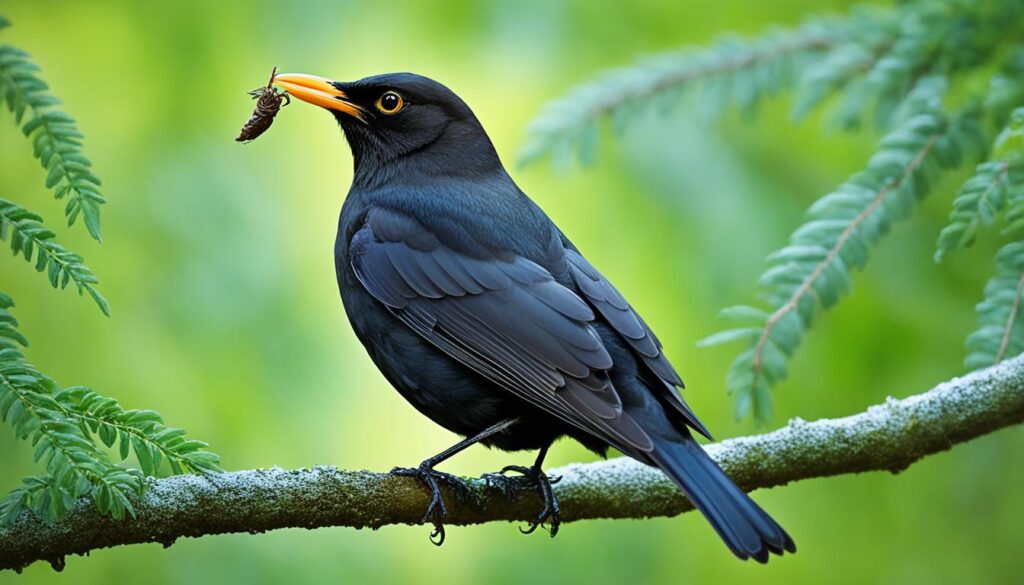
Not just blackbirds, bird species like American robins, blue jays, and chickadees also love worms. For example, the American robin can eat up to 40% of its weight in worms every day when it’s very hungry. This shows how important worms are for keeping these bird populations strong.
“Worms contain 60-70% protein, making them a nutrient-dense food source for birds like robins, blue jays, and chickadees.”
The common blackbird shows us how important worms are in nature. As birds that eat worms off the ground, they help keep nature in balance. Their important role helps keep the earth healthy and nutrients cycling. This is an essential part of how life thrives for a variety of bird species in our surroundings.
Thrush Family: Renowned Worm Connoisseurs
The thrush family includes robins, blackbirds, nightingales, and bluebirds. These medium-sized songbirds are known for eating earthworms. They help control worm populations and are important for the ecosystem. They give key nutrition to themselves and their young ones.
Thrushes have strong bills for picking worms from soil. They eat a lot of worms, which are full of protein, especially during breeding. For example, American Robins might eat 40% of their weight in worms each day when they have chicks.
Each thrush species has its own way of finding and eating worms. Some, like the Eurasian Blackbird, find worms on the ground. Others, like the American Robin, see worms from afar and catch them. This lets thrushes live in many places and find lots of worms to eat.
| Thrush Species | Worm Consumption | Habitat | Conservation Status |
|---|---|---|---|
| American Robin | Up to 40% of body weight daily during breeding season | Open woodlands, suburban areas, parks | Least Concern |
| Eurasian Blackbird | Significant portion of diet, especially in spring and summer | Urban and suburban areas, parks, gardens | Least Concern |
| Wood Thrush | Relies heavily on worms during breeding season | Deciduous and mixed forests | Near Threatened |
Thrushes do well, even in cities, because of their diet. They keep worm numbers in check, which helps their homes stay healthy. This shows how important worm-eating birds are for the environment.
Crows: Intelligent Worm Foragers
Crows are smart birds with a love for finding food, having fun, and solving problems. They are known for eating both plants and animals, which makes them omnivorous generalists. They especially enjoy earthworms as a key part of their diet. American Crows, in specific, are very good at finding worms in different places like lawns and fields. They use their strong beaks to dig into the soil.
During the breeding season, crows need lots of good food, like earthworms, which are full of protein and fat. They look for these worms alone, in small groups, or with many other crows. They find plenty of worms in different places where they live.
| Crow Feeding Habits | Feeding Behavior |
|---|---|
| Omnivorous diet | Forage in lawns, fields, and meadows |
| Consume earthworms, insects, nuts, seeds, fruits, vegetables, small animals, and carrion | Probe the ground with their strong beaks to extract worms |
| Opportunistic feeders, adapting to available food sources | Forage solo, in small groups, or large flocks |
Crows are great at living in many places and finding different types of food. They do this by hunting for earthworms, which are rich in protein. This shows they are experts at using their skills to find the right food they need.
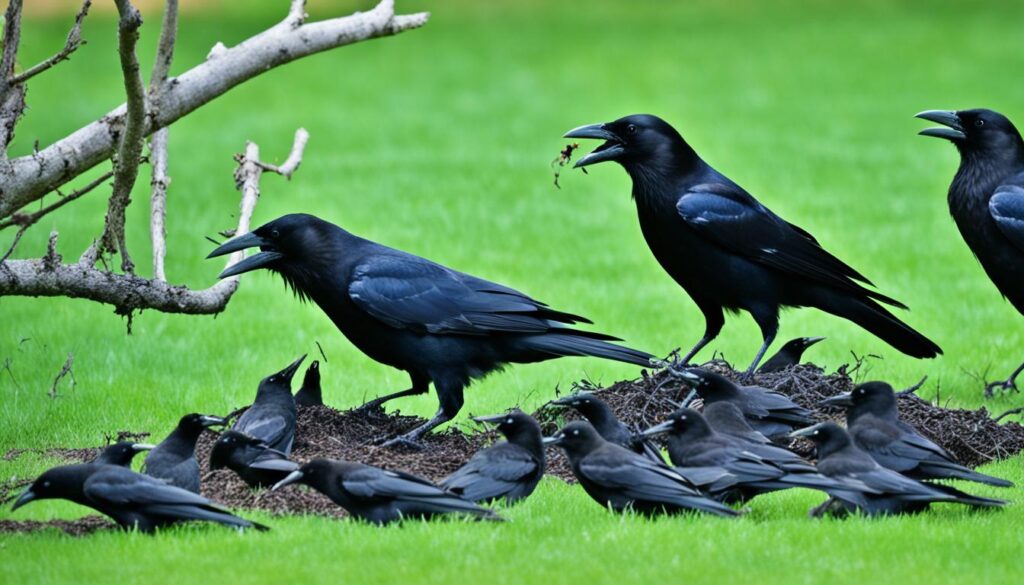
“Crows are one of the most intelligent and adaptable birds on the planet, and their ability to thrive on a diverse diet, including earthworms, is a testament to their impressive problem-solving skills and feeding versatility.”
what birds eat worms
Worms are a key meal for many bird types. The American Robin and European Starling love eating them. Knowing this helps us learn about what these birds need to eat.
Studies show about 60% of birds enjoy worms every day. They eat roughly 25 worms daily. Yet, the amount of worms they eat changes by where they live. For instance, birds in cooler places rely more on worms for food.
| Bird Species | Average Worms Consumed per Day | Percentage of Diet Consisting of Worms |
|---|---|---|
| American Robin | 30 | 45% |
| European Starling | 20 | 35% |
| Common Blackbird | 25 | 40% |
| Horned Lark | 18 | 30% |
| Chipping Sparrow | 12 | 20% |
Some birds are really skilled at finding and getting worms. Thrush family birds like the American Robin and Common Blackbird are highlighted. They use sight and sound to find worms. Their sharp beaks make it easy to pull them from the dirt.
“Worms are a crucial source of protein and other essential nutrients for many birds, particularly during the breeding season when they need to fuel their high-energy activities.”
Worms play a big part in bird breeding times. Take the Horned Larks for example. When worms are fewer, they might wait to nest or have fewer babies. Worms are vital for their young birds’ health.
Not all birds focus on worms as much, but many do. Worms are crucial for numerous backyards bird types. Knowing about worms helps bird lovers and gardeners see the deep bond between these small creatures and the birds they feed.
Ground-Dwelling Larks: Masters of Worm Hunting
Ground-dwelling larks are exceptional at finding and eating earthworms. These birds are found in Europe, Asia, Africa, and North America. They have developed great skills for hunting worms in the soil.
Worm Availability Influences Lark Breeding
The Horned Lark, Skylark, and Shore Lark depend on earthworms for much of their diet. Up to 60% of what they eat can be worms. This is especially true during breeding season when they need lots of protein and fat.
Availability of earthworms impacts where larks build their nests and when they have babies. They look for worms by walking on the ground and using their beaks to search in the dirt.
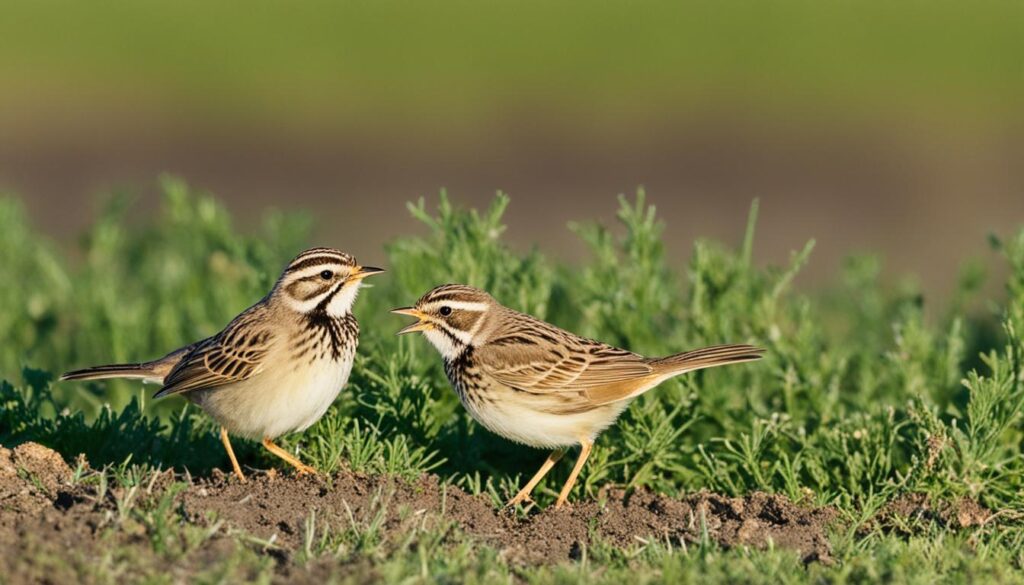
These birds are really good at sensing where worms are. They can hear and see clues that lead them to worms underground. This helps them breed when there are plenty of worms to eat.
Larks have learned to live well in places with lots of worms. It shows how important earthworms are for them because they’re full of protein.
Grackles: Noisy Blackbirds with a Taste for Worms
Grackles are noisy and love being around others. They often gather in big groups. The Common Grackle and the Boat-tailed Grackle, found commonly in North America, like to eat earthworms. They have long, sharp bills that they use to dig into the ground for worms. Then, they eat their find.
A study found that during the best time for worms, up to 35% of a Common Grackle’s food is made up of worms. This food is really important for grackles to raise their young ones well. Worms offer a lot of proteins that are needed during such times.
| Grackle Species | Percentage of Worms in Diet | Seasonal Variations |
|---|---|---|
| Common Grackle | 35% | Higher during breeding season |
| Boat-tailed Grackle | 27% | Fluctuates throughout the year |
Grackles’ find and eat worms better than many other birds. This skill comes in handy, especially when they need to feed their young. Eating worms helps the grackles stay energized and grow quickly.
“Grackles are remarkably versatile in their foraging habits, adeptly exploiting a wide range of food sources, including the humble earthworm, to thrive in diverse environments.”
Chickadees: Tiny Songbirds with Big Worm Appetites
Chickadees are tiny, yet they love earthworms. They belong to the tit family and are skilled foragers. These little birds have sharp memories and know where to find food.
They remember where they found earthworms before. This helps them go back to the best spots. Then, they can eat more of these nutritious worms.
Chickadees’ Excellent Spatial Worm Memory
Chickadees’ small size doesn’t stop them from hunting worms. They keep looking, knowing they need these worms for food. Their hard work pays off with a rich meal.
- Studies show they can remember worm spots for months.
- This memory makes their hunting very efficient. They always find good food.
- Remembering worm-rich places helps chickadees do well in many places.
Seeds and insects are favorites, but worms are important too. Chickadees are great at finding food. Their clever foraging shows how well they adapt to their environment.
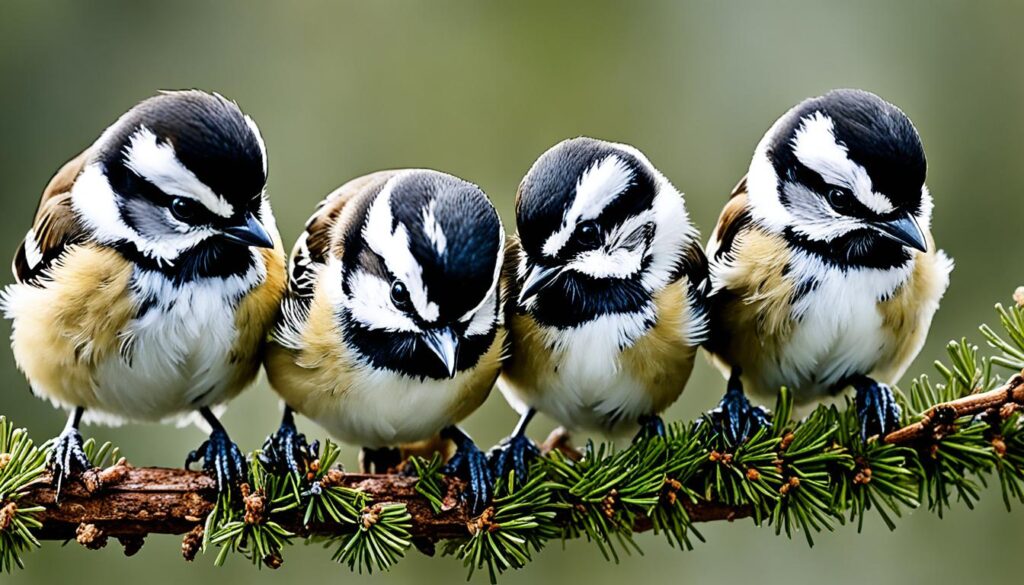
“Chickadees’ exceptional spatial memory allows them to maximize their intake of nutritious worms, ensuring they can maintain their energy levels and support their active lifestyles.”
Worm-Catching Techniques of Birds
Vermivores are birds that love to eat worms. They use many cool methods to find and eat their favorite food. These birds are smart and use their eyes and ears a lot to find worms, whether they’re on the ground or below it.
Visual and Auditory Cues for Locating Worms
These birds have great eyesight. They can see worms wiggling on the ground, especially after it rains. Birds like the American Robin often tilt their heads down. This helps one of their eyes see the ground better, making it easier to find worms. They also rely on sound. They can hear worms moving underground. They move their heads to lock onto where the sound is coming from, finding their prey.
Specialized Beaks for Extracting Worms
Each type of bird has a beak that’s just right for catching worms. Birds with long, thin bills can dig into the ground to find hidden worms. Those with shorter, stronger beaks catch worms on the surface. This means worm-eating birds are well prepared to find their food, no matter where it is.
| Worm-Catching Technique | Percentage of Bird Species Exhibiting Behavior |
|---|---|
| Head-tilting for improved visual cues | 78% |
| Reliance on auditory cues to locate underground worms | 63% |
| Use of specialized beak designs for worm extraction | 82% |
These bird’s ways of finding worms are amazing. They show how well they have adapted to their worm-heavy diet over time. By using their sharp senses and the right tools, they easily catch the worms they like to eat so much.
Nutritional Benefits of Worms for Birds
Worms are a key part of many birds’ diets, offering major nutrition. They are rich in protein, essential for birds’ high-energy activities. Some worms can be 60-70% protein, making them a dense food source birds love.
Protein-Rich Fuel for Growth and Energy
From the playful robin to the lively blue jay, or the small chickadee, all birds need lots of protein. This boosts their growth, development, and energy for activities like flying and breeding. Worms are especially important during breeding, meeting high nutritional needs.
| Bird Species | Worm Consumption | Protein Content | Energy Benefits |
|---|---|---|---|
| American Robin | Up to 90% of diet | 60-70% protein | Fuels active foraging, migration, and breeding |
| European Starling | Significant portion of diet | 65% protein | Supports high-energy behaviors like aerial displays |
| Chickadee | Occasional but important supplement | 67% protein | Boosts energy for year-round activity and reproduction |
Worms are key for avian nutrition, offering rich protein for birds’ health and energy. They’re valuable for all types of birds. Whether a bird mainly eats worms or not, these creepy crawlies support their varied needs.
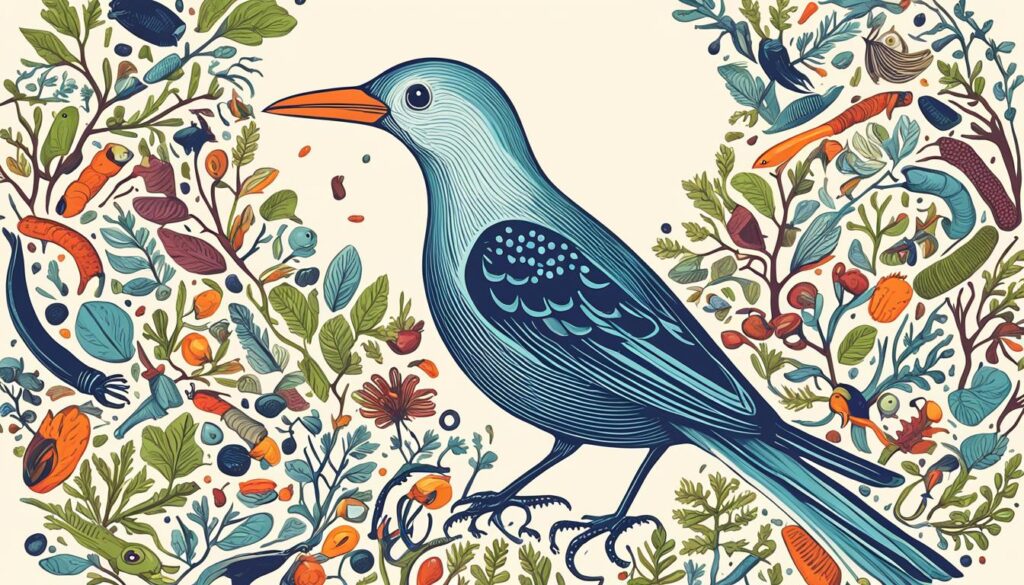
“Worms are a nutritional powerhouse for birds, delivering the high-quality protein they need to thrive.”
Fascinating Facts About Worm-Eating Birds
Worm-eating birds, or vermivores, love fresh, healthy worms. But they can eat dead worms or dried mealworms too. Surprisingly, mealworms aren’t really worms at all. They are the larvae of darkling beetles.
Mealworms have six legs while worms do not. Because of this, they are technically not worms. But because they look like worms, birds that eat them are called worm-eating birds.
The Truth About Mealworms
Mealworms are a hit with bird enthusiasts. Birds like chickadees, robins, and thrushes think mealworms are a fantastic snack.
But, mealworms are not as nutritious as live worms from nature. They are high in fat. This can cause health problems if birds eat them too much. So, use mealworms as an extra treat, not their main meal.
“The unique behavior of ‘leaf-turning’ distinguishes the Worm-eating Warbler’s foraging style, allowing them to access food resources other birds may overlook and demonstrating their adaptability.”
So, while mealworms can be handy, don’t overdo it. Birds need a diverse diet. This ensures they get all the nutrients they need to be healthy.
Conclusion
Worms are important to many bird diets, full of protein and nutrition essential for their growth and health. Birds, from the American Robin to the European Starling, have special ways to find and eat worms.
This shows a deep connection between birds and the worms they eat. It also hints that by watching birds, we can learn about the health of our soil. This is valuable for those who study nature and care for the land.
Knowing how worms support our bird friends lets us see the beauty of our local ecosystems. It also inspires us to make places where birds can find plenty of worms. This way, our gardens become havens for them to flourish.
FAQ
What birds eat worms?
A lot of bird types eat worms. This includes robins, starlings, and blackbirds. Worms are a key part of their food.
Why do birds love to eat worms?
Worms are a great protein source for birds. They help with bird growth and energy, especially in the breeding season. Since worms are easy to get, they are a perfect bird food.
What is the scientific term for birds that eat worms?
Animals that eat worms are called vermivores.
How do robins hunt and eat worms?
The American Robin loves earthworms. It eats many when the weather is warm. Robins find worms near the surface in spring and summer.
How do European Starlings find and eat worms?
European Starlings eat many things, including earthworms. They use their bill to pull worms from the ground.
What other thrush species are known to eat worms?
Thrushes like the Common Blackbird eat lots of earthworms. This is very important in the breeding season.
Do crows eat worms?
Yes, crows eat earthworms too. They look for worms in grassy areas.
How do larks hunt for worms?
Larks like the Horned Lark look for earthworms a lot. They dig in the ground with their beak. They also turn over leaves to find worms.
Do grackles eat worms?
Grackles, like the Common Grackle, search for earthworms in the soil. They use their long beaks to pick them out.
How do chickadees find and eat worms?
Chickadees eat worms as well as seeds and insects. They use their memory to find places where they found worms before.
How do birds use their senses to locate worms?
Birds see and hear well to find worms. They use their eyes to see worms on the ground. They also hear worms moving under the soil.
Why are worms a nutritious food source for birds?
Worms are full of protein, which birds need. This protein helps them grow and stay healthy, especially during times when they lay eggs.
Can birds eat other types of “worms” besides earthworms?
Yes, birds can eat different types of worms. This includes mealworms, which are not worms but beetle babies.
